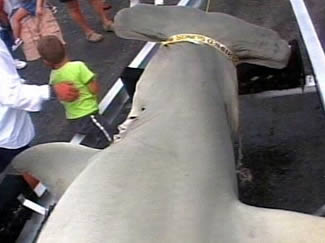
The female great hammerhead was measured at 14.5 feet long and 1,262 pounds
A great hammerhead shark caught by a recreational fisherman in Boca Grande in May was pregnant, scientists at Mote Marine Laboratory confirmed after a necropsy on the animal.
The shark was measured at 14 feet long and 1,280 pounds, with its hammer measuring more than 3 feet across. At the time the shark was brought to Mote, scientists believed it may have been pregnant because its girth was so wide. The necropsy, or animal autopsy, confirmed that.
The great hammerhead, Sphyrna mokarran, that was brought to Mote had 55 shark pups, including 52 that were nearly full-term and three that were undeveloped. That's the largest litter of pups ever found in a great hammerhead shark and scientists at Mote believe this shark was just days away from giving birth. Experts previously believed that great hammerheads gave birth to 20 to 40 pups at a time, so the information gathered from this shark is new knowledge about the species. By comparison, whale sharks – the biggest fish in the ocean – give birth to about 300 pups at a time and smaller sharks give birth to two to 10 pups at a time.
Other notable findings from the necropsy:
- This hammerhead's reproductive tract weighed nearly 250 pounds
- Her stomach contained a whole southern stingray, believed to be the fisherman's bait, and the rear half of an approximately 5-foot-long tarpon, in addition to numerous tarpon scales. The shark also had a small fishing hook inside her stomach.
- Her liver weighed more than 100 pounds.
- Some of the pups are being saved for future study and scientists have taken samples to be analyzed for genetic makeup. The samples will provide information about the number of males that fathered the pups.
While the status of great hammerheads in the wild is uncertain – and it is legal to harvest them ‑ experts believe their populations are depleted due to fishing pressure and habitat loss.
"Although we are thankful that the fisherman gave this unique specimen to Mote, and we are learning a lot about this species from this large female shark, we were saddened to see so many unborn pups inside her so close to birth," said Dr. Robert Hueter, director of Mote's Center for Shark Research. "We ask fishermen not to kill sharks for sport and to remember that shark populations have been severely depleted by overfishing. Very large sharks like this hammerhead are often pregnant females that help maintain the status of the species' population into the future. We advocate release of these large sharks and the tagging of them whenever possible."
The shark carcass has been moved to Ocean Creations in Dover, Fla., where owner Steve Brancati will take a plaster cast for mounting. A full cast will be made and an educational exhibit about sharks and their status will be created at Mote Aquarium. Mote expects the shark display to go up in the fall.
Whether or not this great hammerhead shark was a record catch on rod and reel is still being decided, according to officials with the International Game Fish Association in Dania, Fla. A decision will be made sometime in late July, after a review process is complete.
The National Marine Fisheries Service runs a volunteer shark tagging program. For more information on the NMFS Cooperative Shark Tagging Program, contact: Apex Predators Program, NOAA/NMFS/NEFSC, 28 Tarzwell Drive, Narragansett, RI 02882-1199.
Recreational fishermen can also help shark scientists by keeping an eye out for tags when they catch sharks, Hueter said. Mote has tagged more than 15,000 sharks of 16 species in U.S. waters since 1991 and information provided about these tagged sharks by fishermen helps scientists understand where the fish travel and the different habitats they use.
Anglers can send the tag and other information about the catch to the Center for Shark Research, Mote Marine Laboratory, 1600 Ken Thompson Parkway, Sarasota, FL 34236. They should include their name, address and phone number, date and location of capture along with the total length and weight of the shark (or an estimate) and whether it was kept or released. Anglers can call 800-691-MOTE (800-691-6683) to make a report.
Fishermen who return the tag information to Mote have their names entered into a yearly drawing for a chance to win a cash prize.
